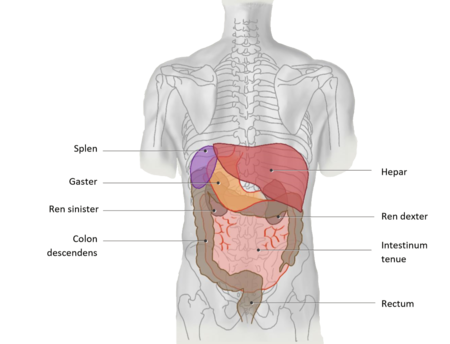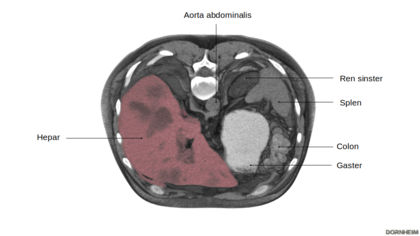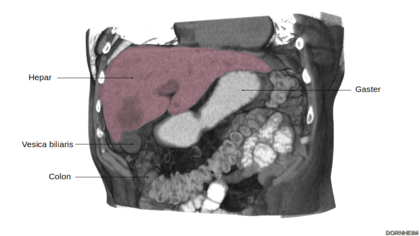Leber (Hepar)/en: Unterschied zwischen den Versionen
Becher (Diskussion | Beiträge) (Die Seite wurde neu angelegt: „<table border="1" cellpadding="10"> <tr> <td><b>View from dorsal to the superior pars of the <i>Facies diaphragmatica</i></b> <!-- [segmenter_snapshot he…“) |
Becher (Diskussion | Beiträge) (Die Seite wurde neu angelegt: „<td> From the ventral view, the two liver lobes, the large <i>Lobus hepatis dexter</i> and the smaller <i>Lobus hepatis sinister</i>, are clearly visible. The…“) |
||
| Zeile 29: | Zeile 29: | ||
<td> | <td> | ||
| − | + | From the ventral view, the two liver lobes, the large <i>Lobus hepatis dexter</i> and the smaller <i>Lobus hepatis sinister</i>, are clearly visible. The <i>Lig. falciforme hepatis</i> runs between the two lobes. The <i>Ligamentum falciforme hepatis</i> forms the <i>Mesohepaticum ventrale</i> and thus the connection between liver and abdominal wall. | |
</td> | </td> | ||
Version vom 3. Januar 2020, 13:12 Uhr
Inhaltsverzeichnis
Function of the liver
As the largest and most important metabolic organ, the liver has various tasks in the human body. It produces vital proteins and is significantly involved in the utilization of food components as well as the breakdown and excretion of substances.
Structure of the liver
<segmenter>https://dornheim.cloud/index.php/apps/segmenter/embedding/view?identifier=UfUm4eWaRri1</segmenter>
| View from dorsal to the superior pars of the Facies diaphragmatica | View from ventral to the Facies diaphragmatica | View from caudal to the Facies visceralis |
| Most of the liver surface is surrounded by visceral peritoneum. However, the Area nuda remains the only peritoneal free, its surface forming the connective tissue capsule. Outside of peritoneal coverage, the three Vv. hepatica usually leave the liver. A peculiarity is that in the liver only the supplying artery and supplying V. portae hepatis and Ductus choledochus run in the Mesohepaticum, whereas the laxative veins do not. At the transients from the visceral to the parietal peritoneum at the underside of the diaphragm, the connective tissue peritoneal epithelium appears as "strand" (Lig. coronarium). From this connective tissue structure a small tip develops on the left hepatic lobe (appendix fibrosa hepatis). |
From the ventral view, the two liver lobes, the large Lobus hepatis dexter and the smaller Lobus hepatis sinister, are clearly visible. The Lig. falciforme hepatis runs between the two lobes. The Ligamentum falciforme hepatis forms the Mesohepaticum ventrale and thus the connection between liver and abdominal wall. |
Die kaudale Sicht ermöglicht einen Blick auf zwei weitere der insgesamt vier Leberlappen: den Lobus caudatus und den Lobus quadratus hepatis. Das Lig. hepatoduodenale dient der Leber zusammen mit dem Lig. hepatogastricum als Mesohepaticum dorsale und gehört topografisch zum Omentum minus. Die Gallenblase überragt den unteren Leberrand mit dem Fundus und liegt der Facies visceralis eng an. Der Hals der Gallenblase zeigt zur Leberpforte, wo sie in Kontakt mit den extrahepatischen Gallenwegen gelangt. |
Projektion und Topographie
Projektion
Die Leber ist im rechten Oberbauch lokalisiert, reicht aber über das Epigastrium hinaus in den linken Oberbauch. Sie schiebt sich dabei weit vor den Magen, welcher an der Rückseite des linken Leberlappens eine Abdruckstelle (Impressio gastrica) hinterlässt. Der rechte Leberlappen tritt in engen Kontakt mit dem Dickdarm (rechte Flexur), dem Dünndarm (Pars superior), dem oberen Teil der rechten Niere und der rechten Nebenniere. Ihre Abdruckstellen sind ebenfalls entsprechend benannt: Impressio colica, duodenalis, renalis und suprarenalis (siehe „WebViewer“). Die Position der Leber ist stark von der Atmung abhängig, da ihre Unterseite mit dem Zwerchfell verwachsen ist. Alter und Körperhaltung sind ebenso ausschlaggebend für die Lage der Leber. Die Gallenblase liegt dorsal zwischen linkem und rechtem Leberlappen.
Leber in situ
Das dünne Gewebeareal zwischen der Leber und der Kurvatur des Magens wird Omentum minus genannt. Diese seröse Haut kleidet die Peritonealhöhle und ist die ventrale Begrenzung der Bursa omentalis. Diese wird rechts von der Leber begrenzt.
Der nach unten weisende Leberrand ist scharfkantig und gut zu tasten bei einer vergrößerten Leber. Die Leber dehnt sich von der rechten Regio hypochondriaca über die Regio epigastrica bis in den linken Oberbauch aus. Am linken Leberunterrand ist der Magen zu sehen. Die Gallenblase liegt an der Unterseite der Leber und überragt den unteren Leberrand.
Lebersegmente
<segmenter border="1">https://dornheim.cloud/index.php/apps/segmenter/embedding/view?identifier=OiSnWp028ERU</segmenter>
Zuordnung zu Partes und Divisiones
| Pars hepatis sinistra | |
| Segment I | Pars posterior hepatis, Lobus caudatus |
| Segmentum posterius laterale sinistrum (= Segmentum II) Segmentum anterius laterale sinistrum |
Divisio lateralis sinistra |
| Segmentum mediale sinistrum (= Segmentum IV) untergliedert in Segment IVa und IVb |
Divisio medialis sinistra |
| Pars hepatis dextra | |
| Segmentum anterius mediale dextrum (= Segmentum V) Segmentum posterius mediale dextrum |
Divisio medialis dextra |
| Segmentum anterius laterale dextrum (= Segmentum VI) Segmentum posterius laterale dextrum |
Divisio lateralis dextra |
weiterführende Links



